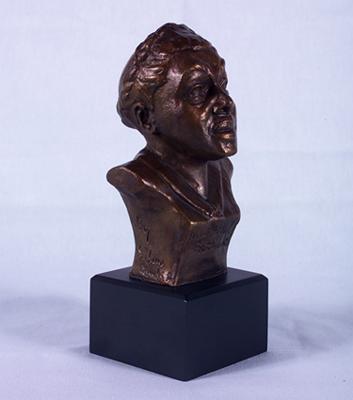Five Women Artists: Selma Hortense Burke
By AnnaLivia McCarthy, Museums intern
Selma Hortense Burke is the second artist featured in this blog series. She may be an artist whose name is unfamiliar to you, but it is likely you encounter her artwork everyday. She is most famous for sculpting the relief profile of Franklin Delano Roosevelt found on the dime.

Selma Hortense Burke, Mary McLeod Bethune, 1946. Bronze, 8 x 4 1/2 inches. Museums Collections.
Burke was an African American sculptor and member of the Harlem Renaissance. She made portrait busts of many notable African American figures including Booker T. Washington, Duke Ellington and Mary McLeod Bethune. A small bronze cast of Burke’s bust of Bethune is part of the Museums Collections.
Mary McLeod Bethune was an educator and civil rights activist who lived from 1875 to 1955. She is known for founding the Daytona Educational and Industrial School for Negro Girls in Daytona, Florida, where she served as president. Today this school still exists as the Bethune-Cookman University. Bethune excelled as a leader. She served as president of the National Association of Colored Women beginning in 1924. She cared deeply for the advancement of African Americans, especially women. She worked to improve the educational, social and political opportunities not only for her students but those throughout the country. For this reason, FDR chose Bethune as a member of his Black Cabinet, a term coined by Bethune herself. She was also a dedicated humanitarian and a philanthropist guided by her religious beliefs and commitment to serving her community.
It is likely that Selma Hortense Burke saw a likeness of herself in Mary McLeod Bethune. Like Bethune, Burke was committed to education. Her focus was in the arts: She founded the Selma Burke School of Sculpture in New York City in 1941 and the Selma Burke Art Center in Pittsburgh, Pennsylvania, in 1968. Both the artist and the person depicted in this sculpture were inspiring women in their time and today.
AnnaLivia McCarthy is an undergraduate intern at Museums.
